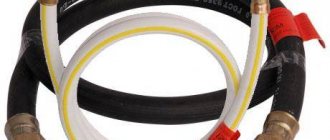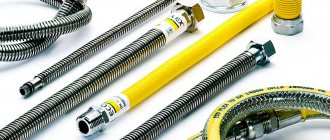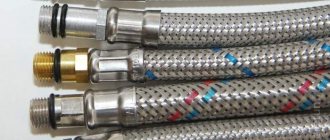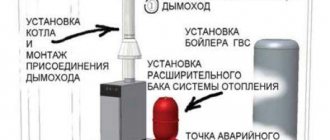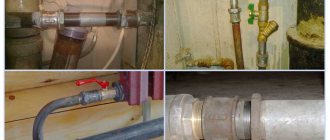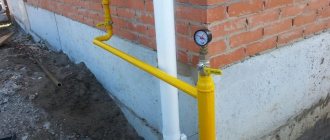Since the appearance of the first gas appliances and until recently, they were connected only with steel pipes.
Now everything has changed dramatically: flexible gas hoses have become firmly established in everyday use, and have already managed to practically displace their outdated predecessors. They are much more convenient to use, easier and faster to connect to the main line.
Don't know what type of hose to choose from the range offered on the market? Let's figure it out together - the article discusses the main types of products used for gas connections, highlighting their advantages and disadvantages.
We also provide useful recommendations for choosing the best flexible eyeliner option. The material is supplemented with video tips and visual photos depicting hoses made of various materials.
Differences between a gas hose and a water hose
For ignorant people, all hoses look the same. And they see the differences between them only in thickness, length and color. Meanwhile, when a pipe is connected for other purposes, it is not far from an accident. And if the gas hose in place of the water supply simply gives a leak, which at most will lead to damage to the interior decoration, then a similar situation with the gas main will definitely lead to a serious accident.
And it’s all about the material for manufacturing and the design of the hose itself. After all, even gas pipes are rarely universal. In most cases, the differences between hose products are quite wide. And for use, the composition of the substance and its state of aggregation are always taken into account.
Initially, all hoses are divided into 2 types. For liquids and gaseous substances. Then the temperature indicators and pressure under which the liquid or gas will be supplied are used. But such a depth of knowledge is not needed by the common man. In order not to get confused and make mistakes, it is enough to pay attention to two indicators.
Flexible gas supply Source sovet-ingenera.com
All gas products are marked yellow. A flexible hose for a gas stove will always differ from a water hose, with a yellow braided thread along its entire length. There are rare exceptions, but then a yellow tag must be hung on the product or a plug of the same color must be placed. Blue or red weaves indicate cold or hot water.
The second indicator is more reliable and provides detailed information. This is the product passport. But you can also ask the seller for a quality certificate. Since gas hoses may differ in material and manufacturing method, as well as in operating characteristics, it would be a good idea to find out all this information.
If you buy hose products not from hand, but from an official dealer, he will always issue a document that clearly indicates which substance the hose is intended for. But for gas pipes there is a small nuance. They always include a special paronite gasket that seals the connection.
Gas pipe kit Source vestnikao.ru
This is a must know valuable advice
Before purchasing a flexible hose, it is necessary to check the size of the thread at the outlet of the plate, its classification and whether it is straight or angular. If the outlet is of a direct type (directed into the wall), you must purchase a sleeve with a square at the end.
The gas hose should not be painted - this will accelerate its cracking. A more attractive look can be created by covering it with special paper or oilcloth.
It is also strictly forbidden to tightly seal gas communications with false plasterboard panels and other structures - this will make it difficult to carry out service work on individual elements.
To camouflage the gas supply system, a collapsible box is used, which can be easily dismantled if necessary. In this case, there will be constant access to all structural elements of the gas system.
It is forbidden to use unnecessary connections. Independent complication of a gas structure, according to technical regulations, may entail a fine or disconnection from gas supply
If a technician was called to connect the gas stove, it is necessary to check that the work was performed correctly: the excess tap from the tap at the lower end should be unscrewed, the flexible line should be directly connected exclusively to the tap located on the branch pipe, and its other end - only to the outlet of the gas stove.
It is also possible to use an adapter. Any additional installations are prohibited.
History of connecting gas stoves
At a time when kitchen stoves using natural gas settled in homes, housewives breathed more freely. Cooking has become faster, and there is no need to use inconvenient kerosene or electric stoves.
Each stove was connected to the home gas pipeline through a steel pipe. The design turned out to be rigid and reliable. It prevented the gas stove from moving even a centimeter. And since the supply of blue fuel to each kitchen was strictly in a certain place, the layout of the room was based on this parameter.
The gas stove stood in a clearly defined place. And if it needed to be moved around the room to remodel the interior, then it required contacting several authorities. Permission to move was obtained from the city gas utility, firefighters and utility workers. Moreover, they could have refused on legal grounds.
Oxygen sleeve Source store.fubag.ru
But about 30 years ago the situation changed. For domestic needs, it became possible to use oxygen hoses. They were made using technology that is used for car tires. The base is woven from heavy-duty cord threads and then filled with rubber. The advantage of the design was relative flexibility and the ability to withstand internal pressure up to 20 atmospheres.
But the oxygen hose for a gas stove had significant disadvantages:
- It couldn't be painted.
- The minimum diameter of the pipe was 16 mm.
- It started to crack when oil got on it.
There was an attempt to create a version of a flexible gas hose with more acceptable performance for domestic purposes. Pipes with a rubber-fabric base appeared. They replaced the cord thread with a special textile one. But the service life of the gas hose for the stove has not increased.
Since such a pipe could be used for no more than 10 years, it was banned for use in apartments. But their production did not stop. They continue to be used at dachas, connecting to gas cylinders.
Rubber hose with fabric weave Source allegroimg.com
See also: Catalog of companies that specialize in autonomous gasification of country houses
Instructions for self-connection
Paying a gas technician for installation work is not too high, but many home craftsmen prefer to do everything themselves. This is a feasible task that requires the purchase of components and theoretical knowledge.
To connect, you will also need to prepare the following tools and buy materials:
- keys: gas No. 1, adjustable 22-24;
- a screwdriver for tightening the clamp, if required;
- sealants (Loctite 55 thread, flax, FUM - tape);
- gasket ½;
- gas sleeve;
- ball valve 1/2′;
- a brush and soap solution, which will be required to control the work.
A rag and a plastic stopper will also come in handy. The rag will be used as a temporary seal against gas leaks. The narrowed edge of the plug must be adjusted to fit the hole in the supply pipe. If during the extraction process a homemade part gets stuck, you can easily remove it with a corkscrew.
Step #1: Removing the old slab
Shutting off the crane when lowering is a primary task to ensure the safety of the work being performed. Next, you need to unscrew the locknut located on the outlet and remove the coupling. If the old slab has a coupling and locknut that were previously painted, this will significantly complicate the process of dismantling them.
Sometimes it is not possible to complete this procedure, then you will need to cut the eyeliner with a grinder.
The gas stove is dismantled after disconnecting the gas main from the conductor pipe. Difficulties that arise with unscrewing the lock nut on a metal pipe can be solved by cutting off the liner
In the process of unscrewing the squeegee located in the lowering valve, it is necessary to hold the valve itself with a key. It does not have to be removed unless you plan to replace the faucet. When they plan to delay the installation of the slab, an additional plug is installed on the lower side.
Step #2: Replace the faucet
There are situations when the wall is located very close to the tap and there is no way to dismantle it. In this case, it is necessary to bend the fastening and install a wedge between the wall and the pipeline. However, this is done in such a way that it is possible to continue doing the work.
It is necessary to prepare a piece of rag sufficient to completely block the pipe after dismantling the old tap. The next thing will be to tear it off without completely unwinding it. You will also need to prepare the selected type of seal. Do not forget to thoroughly ventilate the room during work to eliminate gas vapors.
After unscrewing the tap, the outlet from the pipe is tightly fixed with a finger and then with a wet rag. The main actions are aimed at eliminating gas escape from the pipe as much as possible. In this case, the thread on the branch should not be closed, since it will be covered with the selected sealant.
Before winding the seal, the threads on the lower end must be thoroughly cleaned. Next, its winding is carried out directly. This process ensures a reliable and airtight fixation of the new faucet, which is then tightly screwed on. The last step is to install the previously removed handle on the faucet.
Using soap foam, the tightness of the connection of the faucet and the gas pipe is checked. If the work was completed correctly, installation of the gas hose can continue.
If gas equipment is connected to the mains for the first time, you will definitely need to call a gas technician. In his presence, the equipment is checked for gas leaks when the valve is open. If the gas service worker does not find any violations, he must enter the established brand of stove into the register.
Step #3: Connecting the Flex Hose to the Stove
The external thread of the hose fitting is wrapped with a sealant. After this, it must be screwed into the tap on the branch pipe. The flexible hose is connected to the manifold at the finishing stage.
Next, the stage of test opening the tap on the lower side is mandatory to check for gas leaks. Using soap foam, the joints are treated with a brush. If foaming occurs when opening the gas tap, the work must be redone.
It is necessary to check the threads located on the manifold of the plate. Quite often it is 3/8′. In this case, you will need to install a 1/2′ adapter with a seal
When the work of replacing a gas hose is carried out in a private house where bottled gas is used, an additional replacement of the nozzle with a smaller diameter will be required. If this is not done, the burners will produce too much soot, which likes to settle on furniture and dishes in the kitchen.
Modern products
Rubber products for technical purposes are gradually becoming archaic. They do not last long and begin to crack. But even without this drawback, use is problematic purely in aesthetic terms. Their unpresentable appearance can ruin the interior, and the hose cannot be painted.
But technologies are constantly developing and today the following are produced for kitchen stoves:
- bellows gas hoses;
- rubber reinforced pipe;
- PVC gas hose.
Modern products are technically reliable and have a completely aesthetic appearance. But each type has only its own advantages. To understand which benefits you can use in your home, you need to study each type in more detail.
Rubber reinforced hose
This product is the most widespread due to its low price and sufficient reliability in operation. In appearance, it completely copies a water pipe, but with one exception. A yellow thread is woven along its entire length.
Gas hose with external reinforcement Source allegroimg.com
Hoses are produced in three layers. The inner shell consists of polymers that prevent the vulcanized rubber base from cracking and leaking. And on the outer side there is a braid of steel thread, which increases the rigidity and strength of the base layer. Additionally, the metal cord protects the pipe from mechanical influences.
Since rubber is used in the production of the product, its service life is limited to ten years. Dielectric required. But otherwise, the hose has proven itself to be a reliable and durable element of gas equipment, easy to install.
Reinforced PVC sleeve
The product, like the previous one, consists of 3 layers, but differs in execution. The reinforcing mesh is enclosed between identical layers of polyvinyl chloride. The only differences are in color. The insides are usually black, and the outer covering is yellow over the entire area and length.
PVC gas hose Source stroi-baza.ru
PVC gas hose reinforced with polyester thread has the following advantages:
- Does not require a dielectric because it does not conduct electricity.
- Suitable for mixture from a cylinder and for composition from a gas line.
- Withstands pressure 20 times higher than the working pressure in the pipeline.
- Has different lengths. From 40 cm to 5 m.
- Significantly cheaper than bellows analogues.
- Less susceptible to cracking than a simple rubber hose.
- Service life from 12 to 20 years.
The downside is the lack of rigidity.
What is a bellows eyeliner and what are its advantages?
A bellows gas hose is a corrugated pipe made of stainless steel. Special fittings are installed at the ends of the hose to create a strong and safe connection. The connection to the pipes and equipment is secured using union nuts made of the same material. To increase the level of tightness, metal or plastic sealing rings are installed at the joint.
As a rule, sealing gaskets are included in the flexible hose kit.
Eyeliner kit
The advantages of a bellows hose over other types of flexible hoses designed for connecting gas equipment are:
- strength and rigidity. According to manufacturers' requests, the service life of the bellows is up to 25 years;
- possibility of correct operation at different temperatures;
- not exposed to direct sunlight;
- ability to withstand high pressure;
- possibility of stretching, and when the length increases to 50%, the strength of the liner does not decrease.
The disadvantages include the cost of the equipment, which is 2–3 times higher than the price of rubber analogues.
Optimal selection criteria
The continued safety of the home often depends on the correct choice of product. Therefore, the acquisition task lies ahead with great responsibility. But there are recommendations that significantly narrow the search and subsequently make the purchase easier.
Sequence of actions for choosing a hose:
- Measure the distance from the main to the slab. Under no circumstances should the hose remain in a tensioned position. It's best when it sags a little. This will secure the connection when the slab is forced to move. For example, when cleaning. This is not difficult to ensure, since the length of the gas hose for the stove reaches a maximum of 7 meters.
- It is necessary to consider the gas tap connectors. Receptions on the slab and at the exit from the highway. Because a standard hose has different configurations. It happens that there is a nut with a thread inside at both ends. There are models with a nut and with a fitting.
- You also need to measure the diameter of the fittings both on the equipment and on the line. Half-inch nuts are typically used, but exceptions may apply.
Fittings on the gas pipe Source allegroimg.com
What to do if the diameter of the gas pipeline does not match the boiler pipe
Sometimes the inlet on the boiler may not match the diameter of the gas pipeline. For example, the gas pipe of a Navien floor-standing boiler is 1/2″, and the gas pipeline is 3/4″. Is it possible to connect the device using a DU-15 1/2″ bellows connection instead of 3/4″? Such a transition is permissible, since it is local and does not provide significant resistance.
It is impossible to imagine a modern private house, and especially an apartment in an apartment building, without gas equipment. This could be a stove, a heating boiler, a heating boiler, or other household appliances.
Gas is supplied to a house or apartment through a pipeline system, and from it to each individual consumer via flexible connections. Flexible gas supply can be made in several versions at once.
Briefly about the main thing
To summarize, it should be said that although the most reliable connection is a rigid connection with a metal pipe, modern realities require maneuverability when installing a gas stove. This is primarily necessary to create a beautiful interior. But the practical side also plays a significant role.
The location of the stove will determine how easily and comfortably the housewife can cope with cooking, as well as with household chores. Flexible hoses specially made for gas equipment come to the rescue in solving this problem.
The pipes differ slightly from each other. Usually the properties of the materials used in manufacturing. But for the most part they perform their functions reliably. And the choice of a particular model, as a rule, depends on the location of the stove, its connectors on the taps and accompanying circumstances. For example, will the gas pipe come into contact with other household appliances?
Ratings 0
